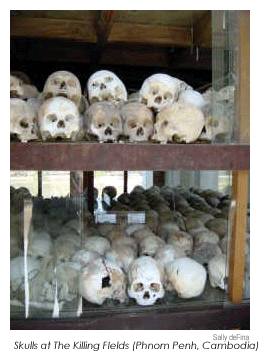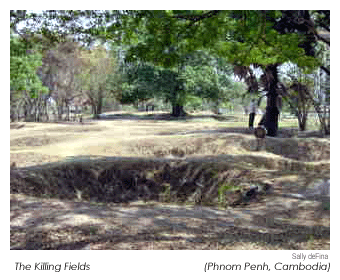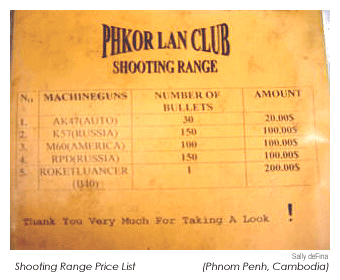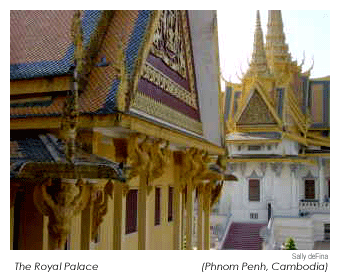| 
#8 - Phnom Penh
Sally
deFina -
March 28, 2002
Phnom Penh is the place to visit if
you have a macabre fascination with the Khmer Rouge. The
Khmer Rouge was the Communist movement that ruled Cambodia from
1975 to 1979. The regime, which was headed by Cambodian guerrilla
commander Pol Pot, came to power after years of guerrilla warfare.
While in power the Khmer Rouge murdered, worked to death, or
killed by starvation close to 1.7 million Cambodians, or more
than one-fifth of the country�s population. The regime accomplished
this by sending almost all of its population to a life of hard
agricultural labor in the countryside, and by out-and-out murder
of members of minority and religious groups, people suspected
of disagreeing with the party, intellectuals, merchants, and
bureaucrats. (Microsoft Encarta)
Mike and I arrived in Phnom
Penh after a gruelling 7 hour boat ride from Siem Riep. We quickly
found a taxi and arranged a price to our preferred hotel - one
recommended in the Lonely Planet guide book. Our driver
promptly took us around the city and then returned to where
he had picked us up...our hotel was less than one block away.
Feeling conned and tired, we caused a scene by refusing to pay
him the $2 agreed upon price (we settled on $1). Unfortunately,
the hotel we ended up with had been turned into a pseudo-brothel
since the write-up in the LP. Rooms were rented by the
hour, 24-hour Thai porn graced the TV, mirrors were placed on
either end of the bed, and quite a few young men milled about
downstairs (a gay brothel?). Too tired too complain, we accepted
our lot and headed out into the city.
 Our
first afternoon in the city was spent at the Tuol Sleng prison
where suspects were held and tortured before being exterminated.
The prison used to be a school before the Khmer Rouge seized
it. The prison was now a museum dedicated to the victims of
the Khmer Rouge genocide. Gruesome paintings, photographs of
victims, and torture instruments were displayed in the cells. But
due to lack of money, the overall condition of the museum was
a bit poor. Our
first afternoon in the city was spent at the Tuol Sleng prison
where suspects were held and tortured before being exterminated.
The prison used to be a school before the Khmer Rouge seized
it. The prison was now a museum dedicated to the victims of
the Khmer Rouge genocide. Gruesome paintings, photographs of
victims, and torture instruments were displayed in the cells. But
due to lack of money, the overall condition of the museum was
a bit poor.
We headed for The Killing Fields outside
of Phnom Penh on our second day. For $2, we rented a driver
on a motor scooter and both of us hopped onto the back for the
half our ride. The only way you would know that thousands
of people died at the location was the monument in the center
of the field filled with skulls. After walking around
the monument, we became aware of the great pits everywhere.
Small signs announced the number of dead buried in each mass
grave. Victims killed here were bludgeoned to death -
apparently because bullets were in such short supply. The place
is very quiet, a place to reflect on the monstrosities that
human beings are capable of inflicting on each other.
 Ever
feel like blowing up a cow? Well, in the Phkor Lan Club shooting
range, you can. You could shoot AK47s (which Mike actually
did) for US$20, or a rocket launcher for US $200. For
an extra US$200, you could shoot a rocket launcher at a cow
(although this was not mentioned on the menu). The fact
that this kind of stuff was on offer meant that there was actually
demand for this crazy stuff. I, personally, could not
understand the attraction with actually firing weapons that
were once used in war. To me it seemed like an insensitive thing
to do after visiting such solemn reminders of the brutal power
of gun wielding lunatics. Mike informs me that it is a guy thing.
Whatever. Ever
feel like blowing up a cow? Well, in the Phkor Lan Club shooting
range, you can. You could shoot AK47s (which Mike actually
did) for US$20, or a rocket launcher for US $200. For
an extra US$200, you could shoot a rocket launcher at a cow
(although this was not mentioned on the menu). The fact
that this kind of stuff was on offer meant that there was actually
demand for this crazy stuff. I, personally, could not
understand the attraction with actually firing weapons that
were once used in war. To me it seemed like an insensitive thing
to do after visiting such solemn reminders of the brutal power
of gun wielding lunatics. Mike informs me that it is a guy thing.
Whatever.
After such a grisly afternoon, we decided
on lighter fare and went to visit the Royal Palace. Cambodia
was a monarchy until 1975, when the Khmer Rouge took over.
Its Royal palace was left intact by the regime and is now a
beautiful place to get away from the hustle and bustle of the
city.
 As
the monarchy was violently replaced by the Khmer Rouge, so too
was the Khmer Rouge violently overthrown by the Vietnamese when
they invaded Phnom Penh in January of 1979. From that moment
until 1989 when the Vietnamese withdrew, the Khmer Rouge waged
a guerrilla war. After the withdrawal, a peace treaty
between the Khmer Rouge and the Cambodian government (set up
by Vietnam) was signed. In 1989 the country abandoned socialism,
and in 1993 a new constitution restored the monarchy. Eventually,
Pol Pot was placed under house arrest and in April 1998, he
died. So far, the government has put very few of the Khmer Rouge
leaders to trial for crimes against humanity. As
the monarchy was violently replaced by the Khmer Rouge, so too
was the Khmer Rouge violently overthrown by the Vietnamese when
they invaded Phnom Penh in January of 1979. From that moment
until 1989 when the Vietnamese withdrew, the Khmer Rouge waged
a guerrilla war. After the withdrawal, a peace treaty
between the Khmer Rouge and the Cambodian government (set up
by Vietnam) was signed. In 1989 the country abandoned socialism,
and in 1993 a new constitution restored the monarchy. Eventually,
Pol Pot was placed under house arrest and in April 1998, he
died. So far, the government has put very few of the Khmer Rouge
leaders to trial for crimes against humanity.
Due to the constant turmoil that has plagued
Cambodia over the last thirty years, its economy is lagging
behind its neighbors in a major way. It is currently one
of the poorest nations in the world (GDP per capita at $270
in 1999. Microsoft Encarta). Its roads are mainly dirt and in
a state of disrepair (it is extraordinarily difficult and time
consuming to get around the country overland) and its citizens
are very poor. Tourism is slowly increasing, especially
to Angkor Wat and Phnom Penh, but with a lack of basic infrastructure
and land mines still littered throughout the land, travelling
to other parts of Cambodia is out of the question for most visitors.
Still, if you want to visit this beautiful country before the
hordes start arriving, now is the time.
 I
found this Lilly on the grounds of the Royal Palace. I
took a photo of it because to me it was such a contradiction
to the overcrowded, poverty-stricken city surrounding me.
I hope that Cambodia, in time, will become as beautiful. I
found this Lilly on the grounds of the Royal Palace. I
took a photo of it because to me it was such a contradiction
to the overcrowded, poverty-stricken city surrounding me.
I hope that Cambodia, in time, will become as beautiful.
|

